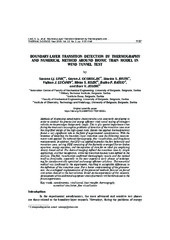Приказ основних података о документу
Boundary-layer transition detection by thermography and numerical method around bionic train model in wind tunnel test
| dc.creator | Linić, Suzana | |
| dc.creator | Ocokoljić, Goran J. | |
| dc.creator | Ristić, Slavica S. | |
| dc.creator | Lučanin, Vojkan J. | |
| dc.creator | Kozić, Mirko S. | |
| dc.creator | Rašuo, Boško | |
| dc.creator | Jegdić, Bore | |
| dc.date.accessioned | 2019-01-30T17:57:46Z | |
| dc.date.available | 2019-01-30T17:57:46Z | |
| dc.date.issued | 2018 | |
| dc.identifier.issn | 0354-9836 | |
| dc.identifier.uri | https://cer.ihtm.bg.ac.rs/handle/123456789/2309 | |
| dc.description.abstract | Methods of diagnosing aerodynamic characteristics are constantly developing in order to conduct the precise and energy efficient wind tunnel testing of transport vehicles in the prototype design early stages. This is of a special importance when facing the time/cost consumption problems of detection of the transition zone over the simplified design of the high-speed train. Herein the applied thermodynamics found a very significant role in the field of experimental aerodynamics. With the intention of detecting the boundary-layer transition zone the following measurements were applied: the infrared thermography, flow visualization, and drag force measurements. In addition, the CFD was applied to predict the flow behaviour and transition zone, solving PDE consisting of the Reynolds-averaged Navier-Stokes equations, energy equation, and the equation of state for an ideal gas employing density-based solver. The thermal imaging defined the transition zone by simple application, and fast recognition, while the transition bounds were defined in the analysis. The flow visualization confirmed thermography results and the method itself as favourable, especially in the most expensive early phases of redesigning for aerodynamically optimized and energy efficient solutions. The numerical method was confirmed by the experiments, resulting in acceptable differences in the definition of the transition zone. For a better understanding of the phenomenon, the overlapped implementation of the presented methods focused on forced convection showed as the best solution. Based on the experiences of this research, development of the additional equipment and adjustments will be introduced in the future experiments. | en |
| dc.publisher | Belgrade : VINČA Institute of Nuclear Sciences | |
| dc.relation | info:eu-repo/grantAgreement/MESTD/Technological Development (TD or TR)/35045/RS// | |
| dc.relation | info:eu-repo/grantAgreement/MESTD/Technological Development (TD or TR)/34028/RS// | |
| dc.relation | Ministry of Education, Science and Technological Development of the Republic of Serbia - 36050 | |
| dc.relation | University of Belgrade, the Faculty of Mechanical Engineering | |
| dc.relation | Military Technical Institute | |
| dc.relation | Institute Gosa | |
| dc.rights | openAccess | |
| dc.rights.uri | https://creativecommons.org/licenses/by-nc-nd/4.0/ | |
| dc.source | Thermal Science | |
| dc.subject | aerodynamics | en |
| dc.subject | wind tunnel | en |
| dc.subject | heat transfer | en |
| dc.subject | thermography | en |
| dc.subject | numerical simulation | en |
| dc.subject | flow visualization | en |
| dc.title | Boundary-layer transition detection by thermography and numerical method around bionic train model in wind tunnel test | en |
| dc.type | article | |
| dc.rights.license | BY-NC-ND | |
| dcterms.abstract | Оцокољиц, Горан Ј.; Линиц, Сузана Љ.; Расуо, Баско П.; Ристиц, Славица С.; Козиц, Мирко С.; Луцанин, Војкан Ј.; Јегдић, Боре; | |
| dc.citation.volume | 22 | |
| dc.citation.issue | 2 | |
| dc.citation.spage | 1137 | |
| dc.citation.epage | 1148 | |
| dc.citation.other | 22(2): 1137-1148 | |
| dc.citation.rank | M22 | |
| dc.identifier.doi | 10.2298/TSCI170619302L | |
| dc.identifier.fulltext | https://cer.ihtm.bg.ac.rs//bitstream/id/8702/2307.pdf | |
| dc.identifier.scopus | 2-s2.0-85047476671 | |
| dc.identifier.wos | 000431923000034 | |
| dc.type.version | publishedVersion |


